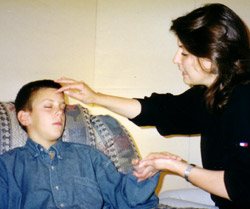
 For 18 years I have heard how some people are not hypnotizable or that hypnosis just doesn’t work. This has not been my experience. First of all, effective hypnosis is a process of developing trust and co-operation. By establishing supportive rapport with clients have a much easier time.
For 18 years I have heard how some people are not hypnotizable or that hypnosis just doesn’t work. This has not been my experience. First of all, effective hypnosis is a process of developing trust and co-operation. By establishing supportive rapport with clients have a much easier time.
If clients feel as though they are working with someone who genuinely cares about their situation they are more willing and able go into the flow of hypnosis. Most practitioners tend to just throw hypnosis at clients who aren’t ready to receive it.
Another important step is to explain the process, to help clients understand that hypnosis is a naturally deep daydream state of mind. By normalizing hypnosis in this way clients can relate to it more easily which ensures a more positive experience.
Lastly, by teaching clients how to do self-hypnosis prior to the formal hypnosis session, they easily slide into deeper hypnosis once the formal session begins.
I empower my clients to relax themselves with some simple breathing techniques and visualization. They are pleasantly surprised by how easy it is to do, which motivates them to continue listening to their MP3 sessions at home which supports lasting success with their goals.
I believe that anybody who wants to be hypnotized can be, it’s not a battle of wills. With a little listening, educating and simple instructions good things usually result.
By: Paul Gustafson RN CH
 As lawmakers debate on bills that could impact the opioid crisis in Tennessee, people have been looking for alternative treatments to help with chronic pain and, in many cases, addiction.
As lawmakers debate on bills that could impact the opioid crisis in Tennessee, people have been looking for alternative treatments to help with chronic pain and, in many cases, addiction.
Steve Olson has been taking individual and group clinical hypnosis sessions at the Osher Center for Integrative Medicine on West End in Nashville.
Olson has been dealing with neuropathy for the last five years. He described the extreme pain to his thighs as a baseball bat hitting him.
“I cannot even sleep with a bed sheet on my legs because the weight of a bed sheet would be extremely painful, so I would sleep on top of the bed,” Olson told NewsChannel 5. He was active and had a job, but the pain was so unbearable that Olson had to quit and rely on heavy amounts of drugs, including muscle relaxers.
He showed us nearly three pages of medications he had to take. At least one doctor wanted to increase his dosage. “Percocet was seven to eight times a day, and sometimes ten times a day. Morphine was three to four a day. I would basically sit in the chair and stare at the television and sit there and cry for hours,” recalled Olson.
Tennessee is one of the states with the highest number of opioid prescriptions per person, according to the Centers for Disease Control and  Prevention. Alabama, Mississippi, and Arkansas also join the list.
Prevention. Alabama, Mississippi, and Arkansas also join the list.
In January, Governor Bill Haslam proposed an aggressive and comprehensive plan to end the opioid epidemic in the state with three major components, including the legislature addressing prevention by limiting the supply and the dosage of opioid prescriptions.
The 66-year-old Franklin resident even went through at least a dozen doctors and different hospitals for the pain before landing at OCIM.
Dr. Lindsey McKernan helped guide him to a better place and move away from the opioids through hypnosis. “It’s a treatment that focuses between a patient and a provider, and it can be done in a group and an individual setting. It’s about learning a way to relax very deeply where you’re guided into that by a provider,” said McKernan.
She said hypnosis can help reduce the activity of signals firing back and forth between the brain and body when the person is experiencing pain. “It might not be the pain goes completely away, but it could be that your daily pain changes to seven out of ten to five out of ten. That could make the difference between getting out of bed for the day,” added McKernan.
 McKernan emphasized that hypnosis is not what is perceived in Hollywood. It is a method that allows her to relax the brain through “suggestions” and make changes in emotions, mood, thoughts, or how you feel in certain parts of your body. “I think it’s helping me learn to cope with the pain and learn how to live life again,” said Olson.
McKernan emphasized that hypnosis is not what is perceived in Hollywood. It is a method that allows her to relax the brain through “suggestions” and make changes in emotions, mood, thoughts, or how you feel in certain parts of your body. “I think it’s helping me learn to cope with the pain and learn how to live life again,” said Olson.
McKernan started the clinic hypnosis program 18 months ago with a four-hour a week clinic before transitioning to group sessions. The center went from treating four patients to 30 plus every week with a bigger team.
It’s part of research determining the effects of the group program to help with pain and quality of life aspects and how that compares to individual hypnosis. The research will last for another year.
Hypnosis services are covered by most insurances, and if they are done by a trainee under supervision, it is a free service. Most of the clinical services at OCIM are insurance-based, including mindfulness classes. The center’s movement classes (yoga, tai chi), acupuncture, and massage are fee-for-service.
By: Matthew Torres

 Hypnosis has become a common medical tool, used to reduce pain, help people stop smoking and cure them of phobias. But scientists have long argued about whether the hypnotic “trance” is a separate neurophysiological state or simply a product of a hypnotized person’s expectations.
Hypnosis has become a common medical tool, used to reduce pain, help people stop smoking and cure them of phobias. But scientists have long argued about whether the hypnotic “trance” is a separate neurophysiological state or simply a product of a hypnotized person’s expectations.
A study published on Thursday by Stanford researchers offers some evidence for the first explanation, finding that some parts of the brain function differently under hypnosis than during normal consciousness.
The study was conducted with functional magnetic resonance imaging, a scanning method that measures blood flow in the brain. It found changes in activity in brain areas that are thought to be involved in focused attention, the monitoring and control of the body’s functioning, and the awareness and evaluation of a person’s internal and external environments.
“I think we have pretty definitive evidence here that the brain is working differently when a person is in hypnosis,” said Dr. David Spiegel, a professor of psychiatry and behavioral sciences at Stanford who has studied the effectiveness of hypnosis. Functional imaging is a blunt instrument and the findings can be difficult to interpret, especially when a study is looking at activity levels in many brain areas.
professor of psychiatry and behavioral sciences at Stanford who has studied the effectiveness of hypnosis. Functional imaging is a blunt instrument and the findings can be difficult to interpret, especially when a study is looking at activity levels in many brain areas.
Still, Dr. Spiegel said, the findings might help explain the intense absorption, lack of self-consciousness and suggestibility that characterize the hypnotic state.
He said one particularly intriguing finding was that hypnotized subjects showed decreased interaction between a region deep in the brain that is active in self-reflection and daydreaming and areas of the prefrontal cortex involved in planning and executing tasks.
That decreased interaction, Dr. Spiegel said, suggested an explanation for the lack of self-consciousness shown by hypnotized subjects. “That’s why the stage hypnotist can get a football coach to dance like a ballerina without feeling self-conscious about what he’s doing,” Dr. Spiegel said. He added that it might also explain, at least in part, why hypnosis is an effective tool in psychotherapy for getting people to look at a problem in a new way.
 The researchers screened more than 500 potential subjects for susceptibility to hypnosis and then compared brain activity in 36 who scored very highly on tests measuring susceptibility to hypnosis and 21 who had very low scores on those tests.
The researchers screened more than 500 potential subjects for susceptibility to hypnosis and then compared brain activity in 36 who scored very highly on tests measuring susceptibility to hypnosis and 21 who had very low scores on those tests.
Brain activity during hypnosis was also compared with activity during resting periods and during a memory task, for both high and low susceptibility groups.
In the hypnosis task, the subjects were guided through two guided procedures for hypnotic inductions: in one, they were instructed to imagine a time when they felt happiness; in the other, they were told to remember or imagine a vacation.
All the subjects were asked in the study to rate how deeply hypnotized they felt during the inductions. Although some researchers continue to argue that hypnosis is a state produced by people’s expectations, not by biology, Dr. Spiegel said, “At some point, I just think it becomes a kind of self-fulfilling word game. I see hypnosis as a kind of app you haven’t used on your cellphone,” he said. “It’s got all kinds of capacity that people are just figuring out how to use, but if you haven’t used it the phone doesn’t do that.”
By: Erica Goode

An easy, effective way to control how you feel and enhance success with your goals. [
contact]

This video explains the proper way to listen to a hypnotherapy session.
 Children are often better candidates for hypnosis than adults, says one clinical psychologist, and the process can help resolve such problems as pain, anxiety, bed wetting, and asthma.
Children are often better candidates for hypnosis than adults, says one clinical psychologist, and the process can help resolve such problems as pain, anxiety, bed wetting, and asthma.
Robert Shacter of New York’s Mount Sinai School of Medicine talked about children and hypnosis on The Saturday Early Show. He says children tend to respond to hypnotic suggestion better than adults because they are more in touch with their imaginations.
Children can be hypnotized as early as age 3, he says, adding, “But in my personal experience, I have found that children ages 5 or older respond best to the treatment.”
The easiest way to hypnotize a child is to have them focus on a point, he explains. They will do that until their eyes begin to feel heavy, and they become sleepy. You now have them in a trance-like state. Once they are in this state, you begin to tell the child stories that can alleviate whatever problems they may have.
What role, if any, does the parent play during a hypnosis session?
As in any therapy, it is important for parents to know what is going on. But in the actual session the parent is either not there or in the background. So, they really don’t play any part in the actual therapy.
don’t play any part in the actual therapy.
How many times does a typical child visit a hypnotist?
Most children attend 4 to 8 sessions with a qualified hypnotist. During that time, the hypnotist can teach a child how to hypnotize himself.
How do I know if my child if a candidate for hypnosis?
Most children are good candidates. It just depends on whether the problems they are having can be helped by hypnosis.
Here are some of the problems that might be helped by hypnosis:
- Hypnosis is very effective at alleviating the pain of children undergoing cancer treatments. What we do is help the child go somewhere else, away from the pain. By accessing the unconscious, the child creates images that forces them to focus on something other than the pain they are feeling.
 For example, if you squeezed your hand very tightly to the point that it hurt and then someone asked you to focus on something else, you would not be as aware of the pain in your hand.
For example, if you squeezed your hand very tightly to the point that it hurt and then someone asked you to focus on something else, you would not be as aware of the pain in your hand.
- A child who is anxious often breathes more quickly and has a higher heart rate. With hypnosis, we can teach them to breathe more slowly, lower their heart rate and take them away from whatever is making them anxious.
- Bed Wetting.Many doctors prescribe medicine for children who have a bed-wetting problem. But now more physicians are turning to hypnosis, which has very positive results. Part of the reason that it works so well is that kids play an active role in their treatment rather than just taking a pill.
- When children with asthma feel their throats constricting, they begin to feel anxious and breathe more heavily. With hypnosis, you teach the child to calm down and bring them to another place.
How effective is hypnosis in children?
In the right child, hypnotism can be very successful. Remember: There are some children who have a harder time letting go. But for those who can, the results can be very positive. Another plus of hypnosis is that unlike drugs, the risk of harm is low.
Why aren’t more doctors using hypnotism?
It’s just not taught that much in schools, and some people still don’t want to recognize it as a viable alternative. However, it is becoming more popular, and many insurers will cover it.
By: Ellen Crean CBS News

 For 18 years I have heard how some people are not hypnotizable or that hypnosis just doesn’t work. This has not been my experience. First of all, effective hypnosis is a process of developing trust and co-operation. By establishing supportive rapport with clients have a much easier time.
For 18 years I have heard how some people are not hypnotizable or that hypnosis just doesn’t work. This has not been my experience. First of all, effective hypnosis is a process of developing trust and co-operation. By establishing supportive rapport with clients have a much easier time. As lawmakers debate on bills that could impact the opioid crisis in Tennessee, people have been looking for alternative treatments to help with chronic pain and, in many cases, addiction.
As lawmakers debate on bills that could impact the opioid crisis in Tennessee, people have been looking for alternative treatments to help with chronic pain and, in many cases, addiction. Prevention. Alabama, Mississippi, and Arkansas also join the list.
Prevention. Alabama, Mississippi, and Arkansas also join the list. McKernan emphasized that hypnosis is not what is perceived in Hollywood. It is a method that allows her to relax the brain through “suggestions” and make changes in emotions, mood, thoughts, or how you feel in certain parts of your body. “I think it’s helping me learn to cope with the pain and learn how to live life again,” said Olson.
McKernan emphasized that hypnosis is not what is perceived in Hollywood. It is a method that allows her to relax the brain through “suggestions” and make changes in emotions, mood, thoughts, or how you feel in certain parts of your body. “I think it’s helping me learn to cope with the pain and learn how to live life again,” said Olson.
 Hypnosis has become a common medical tool, used to reduce pain, help people stop smoking and cure them of phobias. But scientists have long argued about whether the hypnotic “trance” is a separate neurophysiological state or simply a product of a hypnotized person’s expectations.
Hypnosis has become a common medical tool, used to reduce pain, help people stop smoking and cure them of phobias. But scientists have long argued about whether the hypnotic “trance” is a separate neurophysiological state or simply a product of a hypnotized person’s expectations. professor of psychiatry and behavioral sciences at Stanford who has studied the effectiveness of hypnosis. Functional imaging is a blunt instrument and the findings can be difficult to interpret, especially when a study is looking at activity levels in many brain areas.
professor of psychiatry and behavioral sciences at Stanford who has studied the effectiveness of hypnosis. Functional imaging is a blunt instrument and the findings can be difficult to interpret, especially when a study is looking at activity levels in many brain areas. The researchers screened more than 500 potential subjects for susceptibility to hypnosis and then compared brain activity in 36 who scored very highly on tests measuring susceptibility to hypnosis and 21 who had very low scores on those tests.
The researchers screened more than 500 potential subjects for susceptibility to hypnosis and then compared brain activity in 36 who scored very highly on tests measuring susceptibility to hypnosis and 21 who had very low scores on those tests.

 Children are often better candidates for hypnosis than adults, says one clinical psychologist, and the process can help resolve such problems as pain, anxiety, bed wetting, and asthma.
Children are often better candidates for hypnosis than adults, says one clinical psychologist, and the process can help resolve such problems as pain, anxiety, bed wetting, and asthma. don’t play any part in the actual therapy.
don’t play any part in the actual therapy. For example, if you squeezed your hand very tightly to the point that it hurt and then someone asked you to focus on something else, you would not be as aware of the pain in your hand.
For example, if you squeezed your hand very tightly to the point that it hurt and then someone asked you to focus on something else, you would not be as aware of the pain in your hand.







